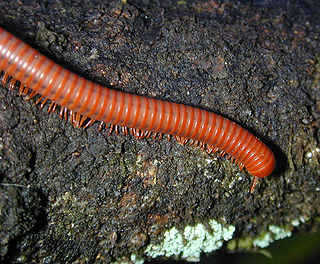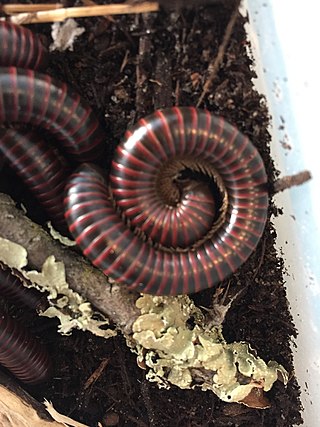
Narceus americanus is a large millipede of eastern North America. Common names include American giant millipede, worm millipede, and iron worm. It inhabits the eastern seaboard of North America west to Georgetown, Texas, north of the Ottine wetlands. It has a nearly cylindrical gray body, reaching a length of 4 inches (100 mm). They can be commonly found in or under decaying logs from March to October. When threatened, they sometimes curl up or release a noxious liquid that contains large amounts of benzoquinones which can cause dermatological burns. This fluid may irritate eyes or skin. Many other millipedes secrete hydrogen cyanide, and while there have also been claims that N. americanus releases hydrogen cyanide, they are unsubstantiated. They do, however, excrete a substance that causes a temporary, non-harmful discoloration of the skin known as millipede burn.

Spirobolida is an order of "round-backed" millipedes containing approximately 500 species in 12 families. Its members are distinguished by the presence of a "pronounced suture that runs "vertically down the front of the head". Most of the species live in the tropics, and many are brightly coloured. Mature males have two pairs of modified legs, the gonopods, consisting of the 8th and 9th leg pair: the posterior gonopods are used in sperm-transfer while the anterior gonopods are fused into a single plate-like structure.

Spirobolidae is a family of millipedes in the order Spirobolida. The family consists of several genera with numerous species, and is commonly divided into the subfamilies Spirobolinae and Tylobolinae.

Trigoniulus corallinus, sometimes called the rusty millipede or common Asian millipede, is a species of millipede widely distributed in the Indo-Malayan region including India, Sri Lanka, China, Taiwan, Myanmar, Thailand, Vietnam, Malaysia, Singapore, and much of Indonesia. It is also reported from Fiji and Tanzania and found in South Asia and the Caribbean as an introduced species. It has also been introduced to Florida, and as of 2022 is well-distributed throughout South and Central Florida, with limited sightings in the Northeast and Panhandle.

William Tinsley Keeton was an American zoologist known internationally for his work on animal behavior, especially bird migration, and for his work on millipede taxonomy. He was a well-liked professor of biology at Cornell University in Ithaca, New York and author of a widely used introductory textbook, Biological Science.

Xystodesmidae is a family of millipedes. Its members often have very small distributional areas, with many species only known from a single locality. They are found across the northern hemisphere, with peak diversity in the Appalachian Mountains, where one-third of the 300 or so species occur. They are particularly abundant in deciduous broadleaf forests in the Mediterranean Basin, Africa, Asia, Central and North America, and Russia. Information on basic taxonomy is scant for this family; for example, it is estimated that the genus Nannaria contains over 200 species, but only 25 were described as of 2006. By 2022, 78 species in Nannaria have been described.

Chordeumatida is a large order of millipedes containing some 1200 species with a nearly worldwide distribution. Also known as sausage millipedes, they grow and develop through a series of moults, adding segments until they reach a fixed number in the adult stage, which is usually the same for a given sex in a given species, at which point the moulting and the addition of segments and legs stop. This mode of development, known as teloanamorphosis, distinguishes this order from most other orders of millipedes, which usually continue to moult as adults, developing through either euanamorphosis or hemianamorphosis.
Branneria is a genus of small millipedes in the order Chordeumatida and the only genus in the family Branneriidae. Individuals reach about 4 mm (0.16 in) long. There are two species known, found in the southeastern USA: Branneria bonoculus is found in Arkansas and eastern Texas while B. carinata occurs from North Carolina to Florida and Mississippi. The adult B. bonoculus millipede has 28 body segments, and the adult B. carinata millipede has 26, both fewer than the 30 usually found in the order Chordeumatida. In both species, the gonopod complex in adult males includes three leg pairs rather than just the two that are usually modified into gonopods in this order.

Tylobolus is a genus of millipedes in the order Spirobolida with seven known species found in western North America. It is in the family Spirobolidae, and is the type genus of the subfamily Tylobolinae. The genus was named by Orator F. Cook in 1904.
Hiltonius is a genus of cylindrical millipedes in the family Spirobolidae comprising 10 species ranging from the southwestern United States to Guatemala, with most species being found in Mexico. The genus was named by Ralph Vary Chamberlin in 1918, after Professor William A. Hilton of Pomona College who collected the type specimen of H. pulchrus.

Harold Frederick Loomis was an American botanist and myriapodologist known for his contributions to agronomy, plant pathology, and millipede taxonomy. He worked for the U.S. Department of Agriculture for over four decades, studying diseases of crop plants, and was a colleague of Orator F. Cook. He also made major contributions to the natural history of Central America and the West Indies, naming over 500 species of millipedes in total. He co-described with Cook the leggiest animal on earth: Illacme plenipes, with over 700 legs.
Floridobolus is a genus of millipedes commonly known as Florida scrub millipedes containing three described species: Floridobolus penneri, F. orini, and F. floydi; the latter two described in 2014. All three species are endemic to Florida scrub habitat of peninsular Florida, and F. penneri is considered a critically imperiled species by NatureServe. Prior to the description of F. orini, the genus was considered the sole member of the family Floridobolidae, named by William T. Keeton in 1959, however studies in 2014 have argued that Floridobolus does not represent a distinct family but rather is a basal member of the family Spirobolidae, representing the subfamily Floridobolinae, and tribe Floridobolini.

Paeromopus is a genus of large cylindrical millipedes endemic to the U.S. state of California. All species exceed 10 centimeters in length, and the largest, P. paniculus, reaching 16.5 cm is the longest millipede species in North America. The genus was named by German entomologist Ferdinand Karsch in 1881 and contains four species: three occupying small ranges in the Sierra Nevada mountains and one occupying a large range including the Sierra Nevada and much of Northern California to the Central Coast.

Narceus gordanus is a spirobolid millipede native to the southeastern United States. Common names include Smokey Oak Millipede and Smokey Ghost Millipede. Adults range from around 60 to 120 mm in length, up to 13 mm wide, and possess 45 to 65 body segments. The body color is lighter than other species of Narceus, with each body ring a light greenish tan followed by a band of darker tan. N. gordanus also has shorter legs than other Narceus species, and a deeper groove on the head in which the antennae rest.

Chicobolus spinigerus, commonly known as the ivory millipede or Florida ivory millipede, is a millipede species native to the southeastern United States, occurring throughout the Florida Peninsula and Panhandle, as well as southern Alabama, Georgia, and South Carolina. Males normally range from 40 to 85 mm long, females up to 90 mm (3.5 in).
Traklosia is a genus of nematodes. The genus was originally circumscribed in 1961 under the name Robertia; L. Travassos and G. R. Kloss created this genus for their newly-described species R. leiperi. The nomen novum, Traklosia, was created for this genus in 2015 — Robertia was an invalid name due to a senior homonym. It consists of three species found in Brazil and Cuba, and they are parasites of millipedes.
Hiltonius pulchrus is a species of millipede in the family Spirobolidae, endemic to the United States. It occurs in California from Kern County to San Diego County.

Abacion is a genus of crested millipedes in the family Abacionidae. There are about 10 described species in Abacion.
Narceus woodruffi is a species of millipede endemic to Florida. Described in 1959, it is the smallest species of the genus Narceus, with adults measuring up to 50 mm in length and 4 mm in width.

Tylobolus castaneus is a species of millipede in the family Spirobolidae. It is found in Northern California, typically between Fresno and Contra Costa.













